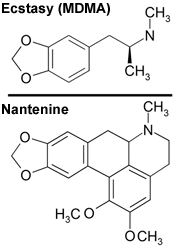|
September 6, 2005
 Some people who use the drug Ecstasy (MDMA)
become hyperthermic (overheated) and die from heart or kidney failure.
Researchers have now discovered a compound in the fruit of the heavenly bamboo plant
(Nandina domestica) that blocks and reverses
the Ecstasy-induced hyperthermia in mice.
Some people who use the drug Ecstasy (MDMA)
become hyperthermic (overheated) and die from heart or kidney failure.
Researchers have now discovered a compound in the fruit of the heavenly bamboo plant
(Nandina domestica) that blocks and reverses
the Ecstasy-induced hyperthermia in mice.
 Nandina domestica (also known as the Thunberg plant, heavenly
bamboo or sacred bamboo) is found in most parts of the United States.
Extracts from the roots, leaves and stems of this plant are thought to
have some medicinal value in treating respiratory problems. A team of
researchers led by Dr. William E. Fantegrossi (Department of Pharmacology,
University of Michigan) noticed that the chemical structure of
nantenine, a compound found in the plant, was similar to that of
Ecstasy. The team was aware that nantenine effects both serotonin and
epinephrine neurotransmitter systems and calcium channels. Could
nantenine somehow block the effects of MDMA?
Nandina domestica (also known as the Thunberg plant, heavenly
bamboo or sacred bamboo) is found in most parts of the United States.
Extracts from the roots, leaves and stems of this plant are thought to
have some medicinal value in treating respiratory problems. A team of
researchers led by Dr. William E. Fantegrossi (Department of Pharmacology,
University of Michigan) noticed that the chemical structure of
nantenine, a compound found in the plant, was similar to that of
Ecstasy. The team was aware that nantenine effects both serotonin and
epinephrine neurotransmitter systems and calcium channels. Could
nantenine somehow block the effects of MDMA?
The scientists tested the effects of nantenine on mice. To start, mice
were implanted with small transmitters to measure body temperature.
These transmitters sent radio signals to devices to record the body
temperature of the mice.
Experiment 1: Does nantenine block the hyperthemic
effects of MDMA?
 Method: Mice were injected with
nantenine before they were injected with MDMA. Method: Mice were injected with
nantenine before they were injected with MDMA.
 Results: Mice injected with
nantenine did NOT become hyperthermic when they were
exposed to MDMA. If mice did not receive nantenine, they became
hyperthemic 30 minutes after MDMA and their body temperature remained high
for about two hours. Results: Mice injected with
nantenine did NOT become hyperthermic when they were
exposed to MDMA. If mice did not receive nantenine, they became
hyperthemic 30 minutes after MDMA and their body temperature remained high
for about two hours.
 Experiment 2: Does nantenine reverse the hyperthemic
effects of MDMA?
Experiment 2: Does nantenine reverse the hyperthemic
effects of MDMA?
 Method: Mice were injected with
nantenine after they were injected with MDMA. Method: Mice were injected with
nantenine after they were injected with MDMA.
 Results: All mice became
hyperthermic after they were injected with
MDMA. However, if the mice received an injection of nantenine 30 minutes
after MDMA, their body temperature returned to normal quickly. Mice
that did not receive nantenine after MDMA remained hyperthermic for
about two hours. Results: All mice became
hyperthermic after they were injected with
MDMA. However, if the mice received an injection of nantenine 30 minutes
after MDMA, their body temperature returned to normal quickly. Mice
that did not receive nantenine after MDMA remained hyperthermic for
about two hours.
These data suggest that nantenine may be used to treat people who develop
dangerous fevers after they take Ecstasy. This is hopeful news because
there are not many treatments currently available to treat people who
overdose on Ecstasy. If nantenine works in people the same way that it
does in mice, doctors will have a new tool to prevent Ecstasy-induced
hyperthermia. | 



![[email]](./gif/menue.gif)


